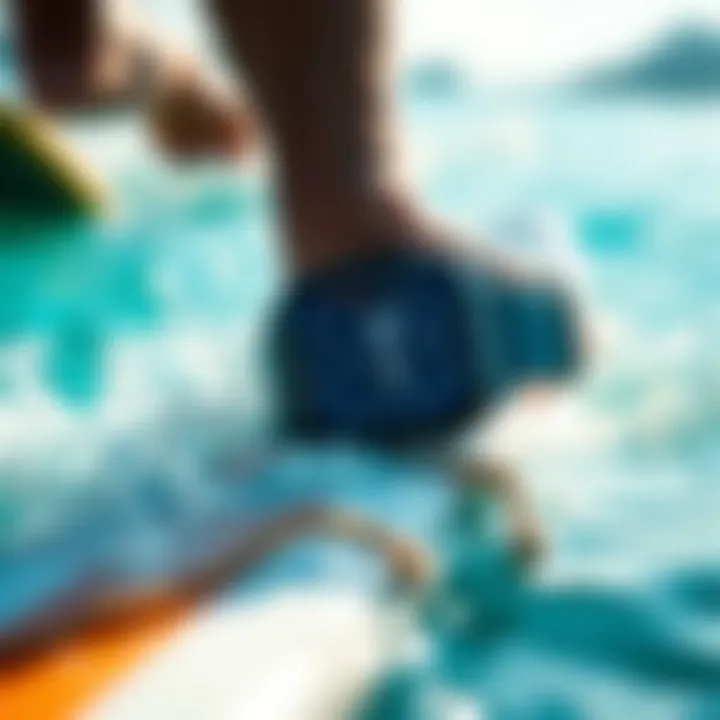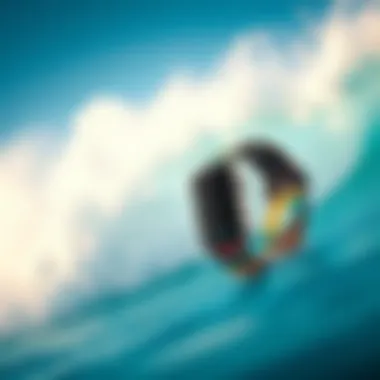Top Apple Watch Bands for Surfing Enthusiasts


Intro
For anyone who chases waves, the right gear makes all the difference. This extends beyond just your surfboard to include the tiny yet mighty gadgets like the Apple Watch. Selecting an Apple Watch band designed for the rigors of surfing requires some thought. After all, you’re looking for something that won’t flinch at saltwater or sand and that stays firmly attached even during the wildest wipeouts.
As surfers, we know that while the board is your number one, a reliable watch can help keep track of time, check tidal information, and maybe even monitor your heart rate while you’re battling those waves. But not just any band will do. In this guide, we explore the best Apple Watch bands for surfing, arming you with insights to make the best choice for your aquatic adventures.
Why Band Selection Matters
When it comes down to it, choosing the right band isn’t a matter of style alone. Surfers encounter unique demands: flexible yet tight fits, comfort against the skin, and materials that resist wear and tear. A poorly chosen band can lead to slippages, discomfort, or even loss of the watch altogether. Thus, finding a band that excels in all these areas is essential to maintaining your focus on the waves, not your gear.
So, let’s plunge into the ocean of options available and find what suits you best. We'll navigate through various categories of bands focusing on their materials, comfort levels, and suitability for surfing to ensure you're well-equipped for whatever the sea throws your way.
Understanding the Needs for Surfing
When it comes to surfing, there is much more at play than just riding the waves. An Apple Watch can be a surfer's trusty companion, offering valuable insights and keeping track of performance metrics. However, choosing the right band is crucial for maximizing the watch's potential in the challenging marine environment. In this section, we delve into the role of an Apple Watch in surfing and examine the unique challenges faced by surfers that affect their choice of watch bands.
The Role of an Apple Watch in Surfing
An Apple Watch serves several functions for surfers, transforming how they interact with their sport. First and foremost, it allows surfers to track their activity—monitoring wave count, speed, and even the distance traveled. With the right apps, the watch can gauge conditions, help plan surf sessions, and provide real-time data that may boost a surfer's performance.
Moreover, safety features like the SOS function can be key during emergency situations, lending a level of security. Additionally, having your notifications handy allows surfers to stay connected without needing their phones at the beach. In essence, the Apple Watch acts as an important tool for recording experiences while also enhancing safety and connectivity.
Challenges Faced in a Marine Environment
The ocean is a unique and sometimes harsh environment. Surfers frequently contend with saltwater, waves, and changing weather conditions, all of which can take a toll on gear, including Apple Watch bands. Here are a few challenges unique to surfing:
- Exposure to Saltwater: Salt can corrode materials that aren't resistant, leading to shorter lifespans for regular bands.
- Surging Waves: Intense water pressure and the risk of getting knocked around require a band that can withstand rough conditions.
- Temperature Fluctuations: From chilly mornings to balmy afternoons, surfers face varying temperatures that can impact comfort and fit.
- Sand and Debris: Getting sand trapped in the band can become irritating, leading to rashes or discomfort during long surf sessions.
By understanding these needs and challenges, surfers can better appreciate why selecting the right Apple Watch band is critical. It’s not just about aesthetics; it's about performance, comfort, and survivability in the ocean's unpredictable nature.
Key Features of Ideal Surfing Bands
When it comes to selecting an Apple Watch band for surfing, several key features come into play. The vast and unpredictable marine environment presents unique requirements that a band must fulfill to support functionality and enhance the surfing experience. Understanding these features can help surfers make informed decisions, ensuring that their gadget not only withstands the elements but also serves its purpose well.
Material Considerations
Materials are paramount when choosing a band for surfing. Here, we explore four popular choices: silicone, nylon, leather, and metal, each bringing its own set of virtues and drawbacks.
Silicone
Silicone is a favorite among surfers due to its flexibility and water-friendly nature. Not only is it soft against the skin, but silicone bands also grip well, which is essential when riding the waves. Their waterproof qualities do wonders when faced with saltwater exposure, allowing for comfort and ease of use. However, one pitfall is that they can trap moisture, possibly causing irritation after long sessions. Despite this, the versatility and low maintenance make silicone a solid choice for many surf enthusiasts.
Nylon
Nylon bands often deliver a lightweight and breathable feel, three key qualities that resonate with surfers. This material can dry relatively quickly and helps to manage sweat, reducing discomfort during strenuous activity. Durability stands out as nylon often resists tearing and fraying better than other fabrics. However, while nylon bands excel in adaptability, they may not offer the same level of waterproof protection as their silicone counterparts, which could be a concern for some surf purists.
Leather


Leather bands add an element of style to any surfer's wrist. They exude sophistication and can transition from beach to bar seamlessly. A leather band can feel quite comfortable and may even mold to the wrist over time, reflecting the wearer’s personality. The downside lies in their need for diligent maintenance; leather doesn't fare well in wet conditions and can deteriorate if not properly cared for. So, while leather provides unmatched aesthetic appeal, its functionality in marine environments is surely limited.
Metal
Metal bands, such as stainless steel or titanium, present a robust and heavy-duty option. Their solid construction indicates longevity, appealing to those looking for a band that stands the test of time both in and out of the water. Metal bands often come with water resistance, though they tend to be heavier than other materials, affecting comfort for some surfers. They can corrode in saltwater if not properly treated, which is an important consideration for those spending nearly all their time in the ocean.
Water Resistance and Durability
Considering the band’s water resistance and durability is critical, especially in the salty embrace of the ocean. A band that can withstand contact with saltwater, surf wax, and constant wear and tear while paddling out or riding strong waves is undoubtedly an asset. Surfers must look for bands marked as corrosion resistant and made from materials that dry quickly to combat the salty aftermath of their adventures. A durable band not only extends the life of the watch but significantly enhances the user experience during surf sessions.
Comfort and Fit
Above all, a band that feels comfortable and fits well is a must. A poor fit can lead to chafing, slipping, or even the risk of losing the watch during a tumble in the surf. When surfing, movements are intensified, putting bands through a rigorous trial. Thus, it’s advisable to choose bands that provide flexibility and can stay put without pinching or constraining. Many manufacturers offer different sizes or adjustable options to ensure surfers can find the perfect fit for their unique wrist shape and size.
Having outlined these key features—materials, water resistance, durability, comfort, and fit—surfers can make more thoughtful decisions when selecting an Apple Watch band that suits their aquatic lifestyle.
Top Apple Watch Bands for Surfing
Choosing the right Apple Watch band for surfing is not just about style; it’s about functionality. When out on the waves, your band can mean the difference between comfort and irritation. The unique environment of the ocean presents certain challenges that specific bands can navigate better than others. This section focuses on the various types of bands available, assessing their key qualities, and why surfers need to consider these features carefully to enhance their overall experience.
Silicone Bands
Comfort and Flexibility
Silicone bands are the go-to for many surf enthusiasts due to their comfort and flexibility. This material is soft to the touch and easily conforms to the wrist, which means it doesn’t pinch or chafe, even during long hauls in the water. The high elasticity of silicone is what makes it such a popular choice; it allows for a snug fit without constricting movement.
A unique trait of silicone bands is their lightness. Surfers appreciate that they feel almost weightless on the wrist, providing freedom of motion as they paddling through the waves. However, it’s worth noting that extreme heat can make silicone bands a bit sticky, which might not be ideal in tropical climates.
Recommended Brands
When it comes to recommended brands for silicone Apple Watch bands, a few stand out. Noteworthy options include brands like Sport Loop, which offers vibrant colors and adjustable lengths for a custom fit. Another brand, Spigen, is known for durable options that hold up well in saltwater environments.
Both brands offer unique features like quick-drying materials and reinforced clasps, ensuring your band stays secure, even during intense surfing activities. The downside? Some silicone bands can stain over time, especially if exposed to sunscreen or seawater frequently.
Nylon and Fabric Bands
Breathability and Lightweight
Nylon and fabric bands are celebrated for their breathability and lightweight properties. The woven design allows air to circulate, preventing sweat from getting trapped against the skin. For surfers, this means comfort even in hot and humid conditions. The soft fibers often feel pleasant against the wrist, which is essential when water sports can already be taxing.
An important characteristic of these bands is their quick-drying ability. Most nylon options can easily wick away moisture, which is a must when you’re constantly jumping in and out of the surf. One downside is that if they get sandy, they can attract debris, albeit they are generally easier to clean than leather or metal bands.
Durable Options
When discussing durable options, brands like Nomad stand out. Their products often include a sturdy nylon weave that can withstand everyday wear and tear while still looking stylish.
They might not be as luxurious as leather, but you won’t compromise on functionality. These bands can handle intense saltwater exposure if rinsed regularly. On the flip side, while they can maintain quality in the short term, prolonged exposure to sun and salt can eventually fade colors, impacting the aesthetic appeal.


Leather Bands
Style vs. Functionality
Leather bands might raise eyebrows when we talk about functionality, but they offer a unique blend of style and functionality. Many surfers appreciate the sleek look they provide, which can transition from beach to dinner effortlessly. However, the sea is their natural enemy; leather doesn’t usually fare well when exposed to water for long periods.
The key feature is often in the craftsmanship—many leather bands are handmade, providing a personalized touch to the Apple Watch. Still, they can lose shape and quality when wet, indicating that while stylish, they aren’t geared towards intense water sports use.
Best Practices for Maintenance
For those choosing leather, knowing the best practices for maintenance is crucial. Regular conditioning with leather cream can keep the material supple and protect against water damage. After each beach day, a gentle wipe with a soft, damp cloth can remove residues and salt, preventing stains.
With proper care, a leather band can last for years, but be aware that any neglect could lead to an unappealing look and potential discomfort when worn, especially in humid conditions.
Metal Bands
Heavy-Duty Options
Looking for heavy-duty options? Metal bands often bring to the table a level of robustness that few other materials can match. Made from stainless steel or titanium, they provide a durability that remains unmatched, able to withstand impacts far better than silicone or nylon.
One downside is that metal bands can feel significantly heavier than their counterparts, potentially leading to fatigue during extended surf sessions. They also run the risk of rust in saltwater environments if not properly maintained, which makes regular maintenance essential for longevity.
Water Resistance Analysis
The water resistance analysis of metal bands can be a tricky subject. Although they are generally water-resistant, it’s important to note that not all bands are created equal. Brands like Milanese Loop offer reliable options that are better suited for water exposure. Yet, most metal bands can corrode if exposed to salty air and water for prolonged periods without rinsing.
This is an important factor that enthusiasts ought to keep in mind when deciding on a band for surfing. While they can provide durability and style, understanding how to care for them in a marine environment will keep your band looking great and functioning well.
Expert Insights on Watch Bands
Understanding the preferences and experiences of those who ride the waves can provide key insights into selecting the most suitable Apple Watch bands for surfing. When professional surfers weigh in, it’s not just about brand names or the latest trends. Their insights can guide everyday surfers in making informed choices that align with both functionality and style. This section presents valuable feedback from experts who rely on their gear to perform at peak levels in the unpredictable marine environment.
Interviews with Professional Surfers
Preferred Materials and Styles
Professional surfers often lean towards specific materials and styles when choosing their Apple Watch bands. It’s not just about aesthetics; the choice of band material plays a crucial role in comfort, durability, and overall practicality. According to industry experts, silicone bands are particularly favored due to their water-friendly characteristics and flexibility. This material is lightweight which doesn't bog them down when caught in waves.
Another popular option is nylon, known for its breathability and ability to dry quickly. Surfers often note that these bands offer a snug fit which helps while paddling out or catching a wave, preventing the watch from shifting around unexpectedly. In essence, a solid choice for anyone navigating surf sessions.
However, leather bands, while stylish, may not be the best fit for intensive water activities. Surfers report that prolonged exposure to saltwater can wear out leather quickly, making maintenance rather troublesome in the long run. Thus, while a leather band provides a sharp look for after-surf outings, functional materials like silicone or nylon often win out in terms of practicality on the water.
Real-World Experiences
Hearing about real-world experiences brings the theoretical choices to life. Professional surfers provide insights into how their watch bands withstand the trials of oceanic conditions. For example, one surfer recounted a wipeout where their watch band held fast against the battering waves, allowing them to monitor crucial metrics throughout the chaos.
The unique feature of securing quick-release mechanisms in some bands has become a game-changer. Many surfers appreciate being able to swap bands between surf sessions and land activities seamlessly. The feedback emphasizes that what works best is a band that not only stays secure while surfing but also transitions well to dry land activities.


Setting Up Your Apple Watch for Surfing
When preparing to hit the waves, getting your Apple Watch ready is as crucial as choosing the right board. The setup can significantly enhance not only your experience in the water but also your ability to track performance, conditions, and health metrics. In this section, we will delve into why setting up your Apple Watch for surfing is essential, followed by specific apps and technology that can elevate your time on the surf.
Apps that Enhance Your Surfing Experience
In the age of technology, the right applications can transform your Apple Watch into a surfer's best friend. Various apps are tailored for surf enthusiasts, offering real-time data that can make a pivotal difference.
- Surfline: This app provides surf reports, live cams, and forecasts. You'll get a real-time view of wave conditions at your favorite spots, which can save you from heading out when it’s flat as a pancake.
- Dolphin: If you are keen on tracking your surf sessions, Dolphin offers detailed metrics, including wave count, total surf time, and distance traveled, perfect for measuring progress.
- Ultimate Surfing Timer: This is more than just a stopwatch. It helps you keep track of your sessions while providing interval training options that can help you get the most out of your time in the water.
Equipping your watch with these apps can streamline your surfing experience, allowing you to focus more on riding waves than checking conditions.
Synchronizing with Surfboard Technology
The synergy between your Apple Watch and surfboard technology is a game changer. Companies like Rip Curl and Nixon have developed smart surfboards that can sync with your Apple Watch. This technology records essential metrics such as your speed, wave height, and even the number of successful rides. By embedding sensors in the surfboard, you can gain insights into your surfing style like never before.
- Rip Curl Search GPS: If you own one of their surfboards with this technology, connecting it with your watch can give live feedback on performance.
- Nixon Smartwatch Integration: This allows you to receive notifications directly from your board and track surfing sessions, providing a seamless experience.
With this level of integration, your surfing can be turned into a science, allowing you to analyze your performance deeply based on real data gathered from both your Apple Watch and surfboard.
"In surfing, knowledge is power; the more you understand your patterns and performance, the better you can improve."
Maintenance and Care for Bands
When it comes to selecting an Apple Watch band for surfing, one of the often overlooked aspects is the maintenance and care required to keep these accessories in top-notch condition. The marine environment, with its saltwater, sun exposure, and potential for grime and sand, poses specific challenges. Just like you wouldn’t neglect your surfboard or wetsuit, your watch band also deserves attention to ensure longevity and performance. A well-cared-for band enhances not only its lifespan but also your overall surfing experience.
Cleaning Recommendations
Cleaning your watch band after each surf session is crucial. Here are some thoughtful steps for you:
- Rinse with Fresh Water: After a day in the ocean, rinse your band under fresh water to remove salt and sand. This is particularly important for silicone or nylon bands, as salt can cause deterioration over time.
- Gentle Soap and Water: Use mild soap and a soft cloth. Avoid harsh chemicals that can wear down the material. For stubborn spots, a soft-bristled toothbrush can work wonders without damaging the surface.
- Drying Thoroughly: After washing, ensure the band is dried completely. A damp band can promote mold or bacteria growth. Lay it flat on a clean, dry towel away from direct sunlight to preserve its color and integrity.
- Regular Inspections: Look out for wear and tear. If you notice fraying, discoloration, or any signs of damage, it’s time to rethink your options. Better to replace it than to risk losing your watch in the waves.
Storing Your Watch Band
When your watch isn’t on your wrist, how you store it can make a significant difference in its lifespan. Here are some good practices:
- Cool and Dry Place: Avoid areas with high humidity; moisture can ruin many materials. Keep your band in a cool, dry drawer or a protective case.
- Avoid Direct Sunlight: Prolonged exposure to sunlight can lead to fading and cracking. If you’ve invested in a quality band, you’ll want to ensure it stays in pristine condition.
- Use a Band Holder: Consider using a dedicated holder or organizer designed for watch bands. This not only keeps them secure but also prevents scratches and other forms of damage.
Closure and Final Thoughts
When it comes to selecting the right Apple Watch band for surfing, understanding your unique needs and preferences is essential. In this article, we’ve navigated through the waters of material choices, durability, and comfort to help you find the perfect match for your aquatic adventures.
Choosing the Right Band for Your Needs
Selecting the appropriate band revolves around several key elements, such as environmental durability and personal comfort. Surfing is not just about riding the waves; it’s also about making sure that your gear works seamlessly in a marine context. A band made from materials like silicone offers flexibility and quick drying, perfect for those unexpected wipe-outs. On the other hand, a nylon band might provide the breathability you need during hot summer sessions, while still ensuring a secure fit.
Each surfer’s experience can vary, making it crucial to choose a band that resonates with your surfing style. Think about whether you prioritize aesthetics or functionality. Some bands may look great on the beach but might not hold up against saltwater corrosion. To ensure the best choice, consider testing a few options before committing — after all, the right band should feel like an extension of your body while you’re out in the surf.
Emphasizing the Importance of Personal Preference
Personal preference plays a monumental role in deciding which Apple Watch band ultimately fits best. What feels comfortable and stylish for one person can be cumbersome for another. For instance, if you prefer a more classic look, a leather band might catch your eye. However, if you’re the type who loves vibrant colors and flexibility, a silicone band might blend with your surfing vibe better.
Moreover, while expert opinions and recommendations are invaluable, they can’t replace your firsthand experience. Engaging with a community, like surfing forums on Reddit, can yield insights, but your own comfort should always steer your final decision.
"The best choice is the one that enhances your surfing experience, feels comfortable, and suits your unique style."



